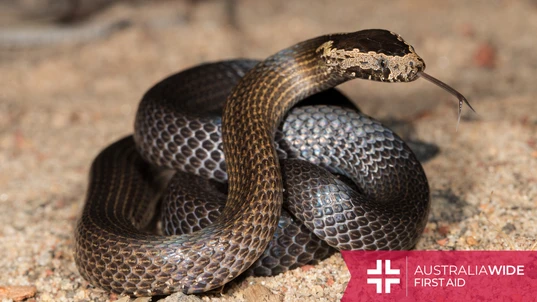The Secretive Golden Crowned Snake

Bites and Stings

The Golden crowned snake is well known for its crown of yellowish scales. Found along the east coast of Australia, this snake is relatively enigmatic due to its secretive and nocturnal nature.
With its crown of yellowish scales, the Golden crowned snake (Cacophis squamulosus) is a sight to behold. And their nocturnal and highly secretive nature only adds to their appeal. Join us as we unravel the mystery of the Golden crowned snake, including what to expect if you are bitten by one. For hands-on experience with snake bites, enrol in one of our general or childcare first aid courses. We have training locations in every state, capital city, and major town throughout Australia - head to our website to find a course near you today.General Description
- Average length of 50 - 75 cm
- Grayish-brown to dark brown scales on their back and sides
- Salmon to orange scales on their belly
- They have a mid line of black spots between their dorsal and ventral scales
- As their name suggests, a yellowish crown-shaped marking on their head
Habitat and Distribution
The Golden crowned snake can be found along the east coast of Australia, from central New South Wales to south-eastern Queensland. In the south, it prefers sandstone areas, while in the north it has a predilection for deep forests and other areas where good, lush ground cover prevails. It typically shelters beneath leaf litter, rocks, and logs.General Habits
The Golden crowned snake is nocturnal and feeds at night, predominantly on lizards, frogs, and blind snakes.Significance to Humans
The Golden crowned snake is not considered dangerous to humans, as they are nocturnal, weakly venomous, and, like most crowned snakes, they prefer to 'mock strike' with their mouth closed. In saying that, they will bite if highly provoked, in which case you should apply correct first aid and seek medical attention. Regardless of whether it is from a Red bellied black snake or a Carpet python, all snake bites should be treated as venomous until proven otherwise by a doctor at a hospital.Final thoughts
It is important to remember, snakes will never go out of their way to attack you. As such, the best way to avoid a snake bite is to refrain from approaching, capturing, or killing snakes at home or in the wild. If you need a snake relocated from your property, contact a professional snake catcher, instead. And to learn more about identifying and treating snake bites, enrol in a general or childcare first aid course near you - we have training locations in every state, capital city, and major town throughout Australia.
Originally published at
https://www.australiawidefirstaid.com.au/resources/golden-crowned-snake
as part of the Australia Wide First Aid Articles Library









